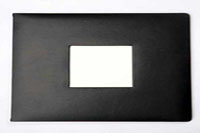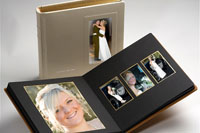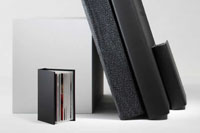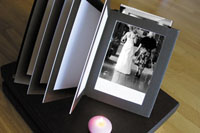Traditional matted wedding albums typically contain a small collection of the best prints from a wedding. Each print is created individually and then slipped in to a page, or adhered to it, perhaps beneath a protective window, edging or margin. Masks of various shapes are sometimes used to achieve special effects and vary the presentation from page to page. A typical album might contain 10, 15 or perhaps 25 leaves, each single side incorporating one or two prints. The albums themselves are available in countless sizes, shapes, colours and finishes. Some are large, extravagant in presentation and consequently expensive. Others are more modest and perhaps bound in plastic rather than leather to keep costs down. Typical sizes for ready-made albums are 8"x8", 10"x10", 10"x12" or perhaps A4 - they are generally available in portrait, square or landscape formats. Some traditional albums are hand made by craftsmen and are works of art in their own right. They may have white, cream, grey or black pages with glassine interleaves, and some have expensive hand-crafted covers and interiors made from hide, suede or other leathers or plastics in various colours. More unusual albums may have metal or wooden covers, perhaps with names and photographs debossed or inset respectively.
| Images courtesy of Graphistudio |
Matted albums are quite different from flush-mounted albums. They contain photographic prints carefully taped to a mat - a card mount featuring a bevelled edge similar to those used in photo frames. The mat frames the picture for better presentation and prevents the print making contact with the adjacent page when the album is closed.The mat itself is then attached to the page. Note that even large prints within such albums do not extend to the edges of a page.Albums of these types have served well over the generations, but imply some limitations in terms of layout and design. A designer must regard each page as a separate entity since it is not normally possible to display an image across a double-page spread. The presentation of each page is consequently restricted by the number of image windows it offers, and the range of masks available to vary the shapes of windows. The number of pages that can be incorporated in to an album of practicable weight and thickness is also limited by the necessarily bulky nature of each page and its associated photographs and masks. Typical albums have about 20 or 25 double-sided leaves incorporating 40 to 50 photographs.
Traditional binding techniques also limit design and layout. The pages are sewn and glued together at the spine and the album cannot therefore be laid flat when opened. There will consequently always be a small valley where the left and right pages of the opened book bend downwards into the spine. This removes from view a small strip of any image that extends to the inner edge of a page. It is difficult to make allowance for this loss of image because the page-cropping and binding processes are not absolutely precise. The two halves of an image presented across a double-page spread would therefore never align correctly.














